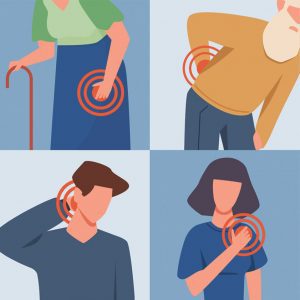 Millions of Americans suffer from chronic constant or intermittent joint pain due to inflammation caused by arthritis, degeneration and/or injury. Knees, shoulders, neck, low back and hips are common places to experience pain, stiffness and immobility, but nearly any joint may be susceptible. When anti-inflammatory medications such as aspirin, ibuprofen (Advil) and naproxen (Aleve) fail to relieve pain or are contraindicated, and rest and physical therapy prove insufficient, joint pain injections may be an option for long-term relief.
Millions of Americans suffer from chronic constant or intermittent joint pain due to inflammation caused by arthritis, degeneration and/or injury. Knees, shoulders, neck, low back and hips are common places to experience pain, stiffness and immobility, but nearly any joint may be susceptible. When anti-inflammatory medications such as aspirin, ibuprofen (Advil) and naproxen (Aleve) fail to relieve pain or are contraindicated, and rest and physical therapy prove insufficient, joint pain injections may be an option for long-term relief.
What Are Joint Pain Injections?
Joint pain injections combine an anti-inflammatory liquid corticosteroid with an anesthetic so medicine can be injected directly into the affected joint space. Using fluoroscopy (advanced x-ray imaging), your radiologist can guide powerful medication directly to the determined source of pain.
Corticosteroid injections can provide lasting relief to:
• Hips, knees, ankles, feet
• Shoulders, elbows, hands
• Facet joints of the spine (including nerve roots into limbs and body)
What Are the Benefits of Joint Pain Injections?
For many patients, joint pain injections provide significant relief from chronic pain and reduce or eliminate the need for anti-inflammatory drugs, which can conflict with other medications and cause stomach pain, internal bleeding and other problems. Joint pain injections can also help limit dependence on opioid pain medications, which are highly addictive, risky and can alter behavior. Relief from joint pain encourages healthy movement and exercise, and greatly enhances life in general. Freedom from pain can create tremendous opportunities across every area of a person’s life.
Joint pain injections are most often performed as an outpatient procedure, are minimally-invasive, and can provide noticeable pain relief within just a few days. While results may vary from one person to another, most people experience significant relief that lasts several months or even longer.
Joint pain injections are also valuable in providing diagnosis of referred pain, which happens when related structures are injured or damaged and transmit pain signals to joints. Knowing the exact origin of pain can be crucial to treating it effectively.
How Are Joint Pain Injections Performed?
Preparation
You will have someone drive you to the procedure and wait to take you home. The entire process usually takes only 30 minutes from start to finish. If you take certain medications like blood thinners, you will be notified beforehand when to stop taking them.
After you check in, you will change into a medical gown and be taken to the treatment room. There, you will lie comfortably on the x-ray table and the skin above the area being treated will be cleaned and numbed with a local anesthetic.
1 Using real-time fluoroscopic imaging, your radiologist will guide a needle directly to the source of pain within the joint. If needed, a contrast agent will be used to verify needle placement. Some pressure may be felt but most patients do not report notable pain.
2 Once your radiologist has confirmed the needle is in the perfect spot in the joint, the area is treated with a mixture of corticosteroid anti-inflammatory medication and an anesthetic to numb any pain during and immediately after the procedure. Once the anesthetic wears off, there may be pain at the injection site(s) and/or within the treated joint, but this usually lasts only a day or two, and may be relieved by applying ice and taking Tylenol.
3 Once the procedure is over, most patients are able to head home after a short waiting period at the office. Unless directed otherwise, you can return to normal activities the following day.
Many patients have some discomfort in the area during the 48 hours following the procedure, but over the next few days experience the full benefit of the medication. Some people find that treatment every 6 months or so is enough to help them remain active with minimal to no joint pain and reduced dependence on oral pain relievers.
Where Can I Get Joint Pain Injections?
RAO provides joint pain injections at our Medical Imaging Center and our TimberRidge location, performed by our experienced team of Board-certified Radiologists.
If you have chronic joint pain, ask your clinician if joint pain injection therapy might be the answer for you. For information and scheduling, call 352-671-4300.
Radiology Associates of Ocala
352-671-4300 | www.RAOcala.com
 Central Florida Health and Wellness Magazine Health and Wellness Articles of the Villages
Central Florida Health and Wellness Magazine Health and Wellness Articles of the Villages



